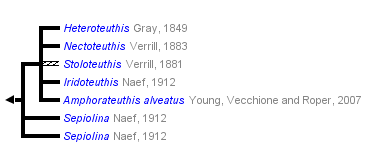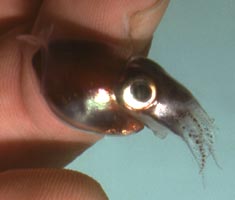Heteroteuthinae
Richard E. Young, Clyde F. E. Roper, and Michael Vecchione


This tree diagram shows the relationships between several groups of organisms.
The root of the current tree connects the organisms featured in this tree to their containing group and the rest of the Tree of Life. The basal branching point in the tree represents the ancestor of the other groups in the tree. This ancestor diversified over time into several descendent subgroups, which are represented as internal nodes and terminal taxa to the right.

You can click on the root to travel down the Tree of Life all the way to the root of all Life, and you can click on the names of descendent subgroups to travel up the Tree of Life all the way to individual species.
For more information on ToL tree formatting, please see Interpreting the Tree or Classification. To learn more about phylogenetic trees, please visit our Phylogenetic Biology pages.
close boxIntroduction
Heteroteuthins are small pelagic or benthopelagic sepiolids. They are easily recognized by their silvery sides and colorful ventral shield. The latter structure appears to be involved in diffusing the light from their large visceral photophore.
Brief diagnosis:
A sepiolid with ...
- ventral mantle shield and silvery sides.
- with arms I-III joined by deep web.
Characteristics
- Arms
- Interbrachial web strongly developed connecting proximal halves of arms I-III.
- Arm suckers biserial except tips of arms IV where they may become more numerous.
- Tentacles
- Tentacular clubs not expanded (except in Sepiolina).
- Keel present only at base of club as narrow elongate fold, paired with a reduced dorsal protective membrane to form "tentacle organ" (except in Sepiolina) of unknown function.
- Mantle
- Ventral mantle margin projects anteriorly.
- Ventral mantle modified optically and morphologically to form "ventral shield." Outside of the Heteroteuthinae a "shield" is found only in Choneteuthis tongaensis.
- Mantle fused to or free from head in nuchal region.
- Gladius
- Gladius absent.
- Viscera
- Bursa copulatrix absent.
- Photophores
- Single visceral photophore (with large circular "lens") on ventral surface of ink sac.
Comments
The ventral shield on the mantle is thought to diffuse the light from the visceral photophore over the region of the shield and thereby aid in counterillumination (eliminate the shadow of the animal created by dim downwelling light). No expermental evidence exists, however, to support this assumption.
The following table compares the six genera.
| Tentacle organ | Arm modifications in males | Enlarged suckers, males | Mantle-head fusion | Funnel locking-apparatus | Length of ventral shield | Posterior fin lobes | |
| Heteroteuthis | Proximal to sucker-bearing club | Strong asymmetry of right arms I & II. Right arm II with glands | Arms III | None | Deep curved goove | 50% VML | Rounded |
| Iridoteuthis | Along much of sucker-bearing club | No strong asymmetry, no glands | Complex or none | Broad | Straight or curved groove and deep, angular pit | >80% VML | Angled |
| Nectoteuthis | Unknown | No asymmetry, arm suckers tubular, glands unknown | Unknown | None | Groove with two pits: Deep, broad anterior; shallow posterior | >80% VML | Rounded |
| Amphorateuthis | Along much of sucker-bearing club | No asymmetry, arm suckers tubular in males. No glands | Arms III | Broad | Straight groove and deep anterior pit | >80% | Angled |
| Sepiolina | Absent | No asymmetry. Arms I with glands | Arms II & III | Narrow | Elongate anterior pit and short groove | >80% VML | Rounded |
| Stoloteuthis | Proximal to sucker-bearing club or barely overlapping | No asymmetry. Arms I with glands | Arms II | Narrow, broad or none | Straight groove | >80% VML | Rounded or angled |
Title Illustrations

| Location | Hawaiian waters |
|---|---|
| Specimen Condition | Live Specimen |
| View | Side |
| Size | 19 mm ML |
| Copyright | © 1996 Thomas Burch |
| Scientific Name | Heteroteuthis hawaiiensis |
|---|---|
| Location | Hawaiian waters |
| View | Side |
| Image Use |
 This media file is licensed under the Creative Commons Attribution-NonCommercial License - Version 3.0. This media file is licensed under the Creative Commons Attribution-NonCommercial License - Version 3.0.
|
| Copyright |
© 2004

|
About This Page

University of Hawaii, Honolulu, HI, USA

Smithsonian Institution, Washington, D. C., USA

National Museum of Natural History, Washington, D. C. , USA
Page copyright © 2019 , , and
 Page: Tree of Life
Heteroteuthinae .
Authored by
Richard E. Young, Clyde F. E. Roper, and Michael Vecchione.
The TEXT of this page is licensed under the
Creative Commons Attribution-NonCommercial License - Version 3.0. Note that images and other media
featured on this page are each governed by their own license, and they may or may not be available
for reuse. Click on an image or a media link to access the media data window, which provides the
relevant licensing information. For the general terms and conditions of ToL material reuse and
redistribution, please see the Tree of Life Copyright
Policies.
Page: Tree of Life
Heteroteuthinae .
Authored by
Richard E. Young, Clyde F. E. Roper, and Michael Vecchione.
The TEXT of this page is licensed under the
Creative Commons Attribution-NonCommercial License - Version 3.0. Note that images and other media
featured on this page are each governed by their own license, and they may or may not be available
for reuse. Click on an image or a media link to access the media data window, which provides the
relevant licensing information. For the general terms and conditions of ToL material reuse and
redistribution, please see the Tree of Life Copyright
Policies.
- First online 30 August 2004
- Content changed 04 November 2015
Citing this page:
Young, Richard E., Clyde F. E. Roper, and Michael Vecchione. 2015. Heteroteuthinae . Version 04 November 2015 (under construction). http://tolweb.org/Heteroteuthinae/20027/2015.11.04 in The Tree of Life Web Project, http://tolweb.org/











 Go to quick links
Go to quick search
Go to navigation for this section of the ToL site
Go to detailed links for the ToL site
Go to quick links
Go to quick search
Go to navigation for this section of the ToL site
Go to detailed links for the ToL site